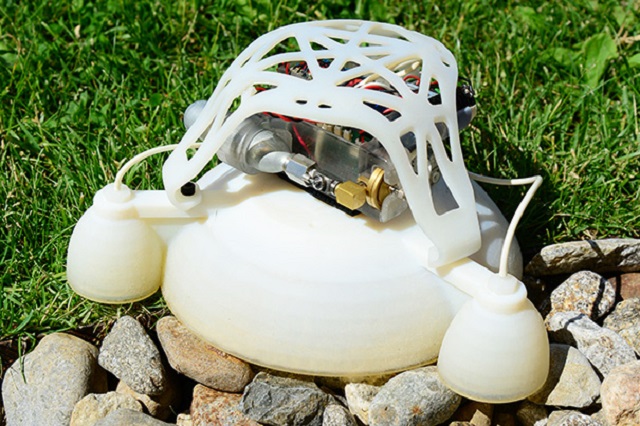 Photo courtesy of Harvard Microrobotics Lab
Photo courtesy of Harvard Microrobotics Lab
We believe that bringing together soft and rigid materials will help create a new generation of fast, agile robots that are more robust and adaptable than their predecessors and can safely work side by side with humans.
Michael Tolley
Assistant Professor of Mechanical Engineering, UC San Diego
Tolley is one of the co-lead authors of the paper along with Nicholas Bartlett, a Ph.D. student in the Microrobotics Laboratory at Harvard. The robot was designed, manufactured and tested by Tolley and Bartlett. Most of the work involved in this study was performed at the Harvard Microrobotics Laboratory.
Tolley states that nature has inspired the blending of hard and soft materials in the body of the robot. The feet of some mussel species are hard and soft in different regions. Its foot begins in a soft form and then at the place where it has to make contact with rocks it becomes stiff. “In nature, complexity has a very low cost,” Tolley said. “Using new manufacturing techniques like 3D printing, we’re trying to translate this to robotics.”
Tolley stated that soft robots that are not tethered to electronics or power sources are quite slow at performing tasks. The team believes that their findings would enable superior integration of rigid components within soft robots. This would enable robots to perform their tasks faster, without endangering the safety of the humans who would be collaboratively working with the robots.
3D-printed robot is hard at heart, soft on the outside
During jumping, the soft layers of the 3D-printed robot lower its risk of getting damaged when it lands after jumping. The rigid layers enable better interface with the power sources and the electronic brains of the device.
Two nestled hemispheres make up this robot. The top hemisphere is a single-piece, 3D-printed half shell that has nine layers with different stiffness. The exterior of the structure has rubber-like flexibility that goes on to become completely rigid near the core. After experimenting with several designs the team found that a robot with a fully rigid top was able to make higher jumps. However, a more flexible top had a better chance of surviving the landing impact, which would enable the robot to be used again. The researchers voted for the design that had more flexibility.
Tolley stated that off-the-shelf materials are used for 3D-printing robots, and it was difficult designing around these materials. The manufacturers of the off-the-shelf materials had not provided detailed specifications and hence the researchers had to print and test each material. This helped them to calculate the specific stiffness possessed by the nine different layers that made up the top half portion of the robot. This data was used for simulation of the robots performance, which helped accelerate the process of robot design.
3D-printed robot is hard at heart, soft on the outside
The flexible bottom half has a small chamber. Just before the robot jumps, butane and oxygen are injected into this chamber. When these gases get ignited, they act like a basketball that becomes inflated in an instant. This makes the robot jump. The bottom hemisphere reverts back to the shape that it was earlier after the charge gets depleted.
The rigid core module comprises a high-voltage power source, miniature air compressor, battery, butane fuel cell, and a custom circuit board, along with other components. This rigid core module is surrounded by the two hemispheres. During the tests, the robot was able to jump to a height of 0.75 meters with a lateral distance of 0.15 meters. It survived more than 100 jumps, and 35 falls from a height of nearly four feet.
The research team has published the details of this study in Science magazine.